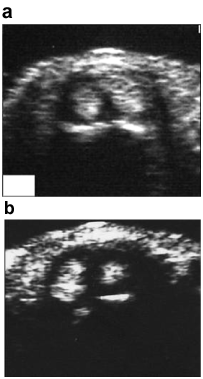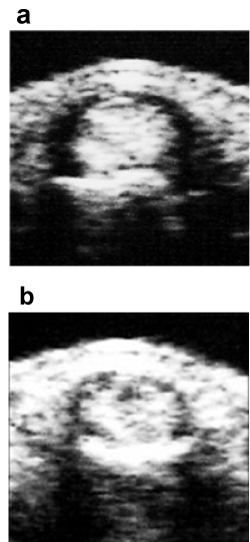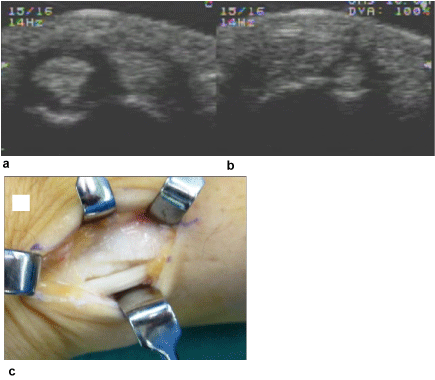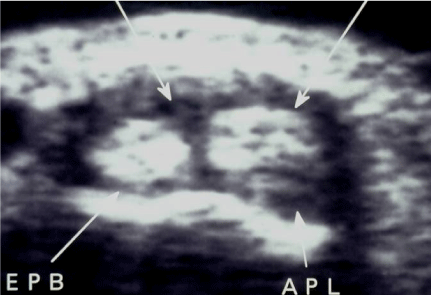Research Article Open Access
Ultrasonographic Evaluation and Treatment for Dequervain’s Disease
| Hiroyuki Shimizu* Moroe Beppu, Takeshi Arai, Toshihito Naito, Masahiro Tanaka, Takuya Sato and Hiroko Misawa | |
| Department of Orthopaedic Surgery, St Marianna University School of Medicine, Kawasaki, Japan | |
| Corresponding Author : | Hiroyuki Shimizu Department of Orthopaedic Surgery St. Marianna University School of Medicine Kawasaki, Kanagawa, Japan Tel No: +81-44-044-977-8111 Fax No: +81-44-044-977-9651 E-mail: h3simizu@marianna-u.ac.jp |
| Received March 08, 2014; Accepted June 19, 2014; Published June 26, 2014 | |
| Citation: Shimizu H, Beppu M, Arai T, Naito T, Tanaka M, et al. (2014) Ultrasonographic Evaluation and Treatment for Dequervain’s Disease. OMICS J Radiol 3:164. doi:10.4172/2167-7964.1000164 | |
| Copyright: © 2014 Shimizu H, et al. This is an open-access article distributed under the terms of the Creative Commons Attribution License, which permits unrestricted use, distribution, and reproduction in any medium, provided the original author and source are credited. | |
Visit for more related articles at Journal of Radiology
Abstract
We performed ultrasonography in patients with de Quervain’s disease to examine the presence or absence of a septum and the extent of hypoechoic areas around tendons. We also compared the ultrasonographic findings with therapeutic outcomes. The subjects were 151 hands (96 conservatively-treated hands, 55 surgically-treated hands) of 146 patients who underwent ultrasonography at the time of initial examination or during treatment. We evaluated the presence or absence of a septum mainly on short axial images and the degree of tendon sheath thickening based on hypoechoic areas around the extensor pollicis brevis and abductor pollicis longus tendons. Among those with a septum and hypoechoic areas around these tendons, more hands were treated surgically, more injections were given, and the time-to-remission tended to be longer. Among those without a septum but with hypoechoic areas, there were more hands responding to conservative therapy. Among those with neither a septum nor a hypoechoic area, there were no surgically treated cases, and remission was obtained in the early stage. According to ultrasonographic findings indicating the presence or absence of a septum and hypoechoic areas, the subjects were classified into 4 types, and these types reflected the therapeutic effects.
| Keywords |
| de Quervain disease; Ultrasonography; Tenosynovitis; Septum |
| Introduction |
| de Quervain’s disease is a stenosing tenosynovitis of the first extensor compartment of the wrist. Because the presence of a septum is prevalent in patients with de Quervain’s disease undergoing surgery, such a septum is considered to be the cause of this disease and to be responsible for its treatment-resistant nature [1]. Thus, if the presence of a septum can be determined by ultrasonography, it may be very useful for treatment planning [2]. We perform ultrasonography to examine the presence or absence of a septum and the extent of any hypoechoic area around tendons. We also employ the ultrasonographic findings to determine therapeutic strategies for this disease. We report our experiences herein. |
| Subjects and Methods |
| This study included 151 hands of 146 patients who were diagnosed as having de Quervain’s disease and underwent ultrasonography at the time of initial examination or during treatment. There were 27 men and 119 women. The ages ranged from 21 to 82 years with a mean of 46 years. The common factors contributing to the onset of this disease were household chores or excessive use of the hands in 119 patients. |
| Ultrasonography of the radial styloid process was performed mainly in the short axial plane to evaluate the presence or absence of a septum and the degrees of tendon sheath thickening based on hypoechoic areas around the extensor pollicis brevis (EPB) and abductor pollicis longus (APL) tendons. The ultrasonographic findings were compared with the therapeutic effects. |
| Results |
| There were 96 hands for which symptoms were relieved by conservative therapy mainly with steroid injections and 55 hands for which treatment was converted to surgery. Based on the ultrasound images and the intraoperative findings, a septum was detected in 77 (51%) of the 151 hands. The frequency of the presence of a septum was 39 (41%) of the 96 conservatively-treated hands and 38 (69%) of the 55 surgically-treated hands. A septum was more prevalent in the surgically-treated cases. The obtained ultrasound images were classified into the following 4 types according to the presence or absence of a septum and the extent of the hypoechoic areas around the tendons: Type 1 (44 hands): cases with a septum and a hypoechoic area only around the EPB (Figure 1a); Type 2 (33 hands): cases with a septum and hypoechoic areas surrounding both the EPB and the APL (Figure 1b); Type 3 (63 hands): cases without a septum but with hypoechoic areas surrounding both the EPB and the APL (Figure 2a); and Type 4 (11 hands): cases with neither a septum nor a hypoechoic area anywhere in the vicinity of the EPB or the APL (Figure 2b). |
| When the therapeutic effects were compared according to these types, both Type-1 and Type-2 cases, which had a septum and a hypoechoic area, were more frequent among the surgically-treated cases (35%). Moreover, in the cases with both types, the number of injections ranged from 1 to 8 (mean: 5.5), and the time-to-remission was longer, ranging from 3 to 10 months (mean: 6.8 months). The Type-3 cases, which did not have a septum but did have a hypoechoic area, were more frequent among the conservatively-treated cases (48%). Furthermore, in the Type-4 cases, which had neither a septum nor a hypoechoic area, none was treated surgically, and remission was obtained with rest or by applying topical agents over short periods ranging from 1 to 4 months (mean: 2.7 months). As described above, among those with a septum and a hypoechoic area, more injections were given, the time-to-remission was longer, and there were more surgically-treated cases. Among those with no hypoechoic area, symptoms were relieved by rest, topical agents, prostheses, etc. The presence or absence of a septum and the extent of the hypoechoic area had an impact on the therapeutic effects. |
| Cases |
| Case 1: A 38-year-old man: Two bands of the APL and one of the EPB were depicted as hyperechoic areas. Only the complete septum and the area surrounding the EPB were depicted as hypoechoic areas (Type 1) (Figure 3a and Figure 3b). The intraoperative findings were consistent with the ultrasonographic findings in terms of the number of tendons and the presence of a septum. The EPB was surrounded by an independent tendon sheath (Figure 3c). |
| Case 2: A 51-year-old woman: Two bands of the APL and one of the EPB were depicted as hyperechoic areas. A complete septum was observed. Hypoechoic areas entirely surrounding the EPB and the APL were visualized (Type 2) (Figure 4) .The intraoperative findings were consistent with the tomographic findings in terms of the number of tendons and the presence of a septum. While the EPB was surrounded by an independent tendon sheath, the septum had been opened. |
| Discussion |
| In de Quervain’s disease, because many patients undergoing surgery have a septum, its presence is considered to make this disease highly resistant to treatment. Ultrasonography is an effective modality for confirming the presence of a septum on images [3-5]. Regarding ultrasonography for this disease, Trentanni et al. [6] divided 14 cases into 3 stages according to tendon thickness and the presence or absence of a septum, as determined on ultrasound images, pointing out that there are differences in responsiveness to treatment. Moreover, Giovagnorio et al. [7] observed swelling of the synovial sheath on images in 8 cases, reporting that ultrasonography is useful for diagnosis and follow-up of treatment. Meanwhile, although magnetic resonance imaging (MRI) is also reported to be useful for confirming the presence of a septum, MRI has disadvantages, including high cost and inability to check the movement of tendons [4]. Ultrasonography is less expensive than MRI, can easily be performed at an outpatient clinic, and can determine the presence of a septum and degrees of tendon sheath thickening. Injections of steroids into the EPB tendon sheath can be ensured by ultrasonography, which contributes to improved outcomes of conservative therapy employing these injections [8,9]. In order to generate accurate ultrasound images, because the area of the radial styloid process is rather small for a probe to be attached, scanning requires innovations, such as the application of highly viscous jelly or insertion of the polymer gel of an acoustic medium. |
| The results of this study indicate that the initial therapeutic strategies for this disease are only rest and topical agents in cases with neither a septum nor hypoechoic areas surrounding the tendons on ultrasound images. For the type without a septum but with hypoechoic areas surrounding the tendons, conservative therapy based on steroid injections should be continued. In cases with a septum, steroids should be injected into the EPB tendon sheath. If remission cannot be obtained, conservative therapy should not be prolonged. Instead, doctors should explain to patients that it will take a long time to obtain remission and should request their consent for surgery. |
| In conclusion, we consider cases of de Quervain’s disease to be divisible into 4 types according to the presence or absence of a septum and a hypoechoic area on ultrasound images. Furthermore, we have found that these types reflect therapeutic effects and can be used for determining the most appropriate therapeutic strategies for this disease. |
References |
|
Figures at a glance
 |
 |
 |
 |
| Figure 1 | Figure 2 | Figure 3 | Figure 4 |
Relevant Topics
- Abdominal Radiology
- AI in Radiology
- Breast Imaging
- Cardiovascular Radiology
- Chest Radiology
- Clinical Radiology
- CT Imaging
- Diagnostic Radiology
- Emergency Radiology
- Fluoroscopy Radiology
- General Radiology
- Genitourinary Radiology
- Interventional Radiology Techniques
- Mammography
- Minimal Invasive surgery
- Musculoskeletal Radiology
- Neuroradiology
- Neuroradiology Advances
- Oral and Maxillofacial Radiology
- Radiography
- Radiology Imaging
- Surgical Radiology
- Tele Radiology
- Therapeutic Radiology
Recommended Journals
Article Tools
Article Usage
- Total views: 13941
- [From(publication date):
September-2014 - Jul 03, 2025] - Breakdown by view type
- HTML page views : 9333
- PDF downloads : 4608
